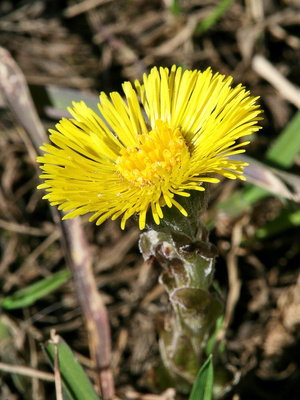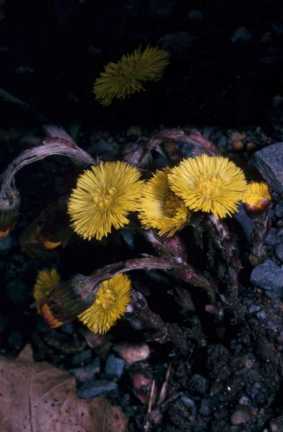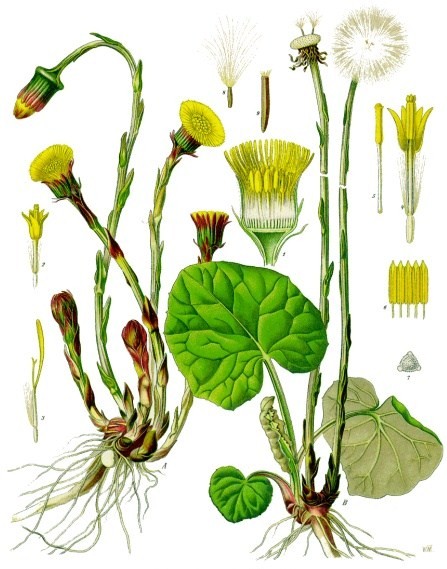
Tussilago farfara (L)
Synonyms and Common names: Fafara, Coughwort, Horsehoof, English tobacco, bullsfoot, foals foot, horsefoot, butterbur, flower velure, hallfoot, fieldhove, donnhove, son before father
French = Tussilage, German = Huflattich, Spanish = Tusilago, Italian = Tossalaggine
Order: Compositae
 Description: Tussilago is a perennial herb with a creeping
rhizome and long runners. Both the flower and the leaf buds grow on the rhizome.
In early spring, erect, unbranched woolly stems, covered with reddish-brown
scales, grow from the flower buds, terminating in a pale yellow flower head, up
to 35mm in diameter, with a single-rowed involucre composed of up to 300
strap-shaped ray florets and up to 40 tubular disc florets. This becomes a white
downy sphere when the long-stalked basal leaves begin to sprout.
These are round, heart-shaped, shallowly toothed at the edges, and divided into
five to twelve lobes. They are glossy and dark green above and greyish below due
to the felt-like hairs covering the underside; the young leaves are
densely felted on both sides. The fruits are long, cylindrical, glabrous achenes,
with shiny white down at the tip, appearing at the same time as the large
leaves. Tussilago is a common invasive weed which prefers heavy clay soils
throughout Britain, Europe, North Africa and Asia and sporadically in the US.
Description: Tussilago is a perennial herb with a creeping
rhizome and long runners. Both the flower and the leaf buds grow on the rhizome.
In early spring, erect, unbranched woolly stems, covered with reddish-brown
scales, grow from the flower buds, terminating in a pale yellow flower head, up
to 35mm in diameter, with a single-rowed involucre composed of up to 300
strap-shaped ray florets and up to 40 tubular disc florets. This becomes a white
downy sphere when the long-stalked basal leaves begin to sprout.
These are round, heart-shaped, shallowly toothed at the edges, and divided into
five to twelve lobes. They are glossy and dark green above and greyish below due
to the felt-like hairs covering the underside; the young leaves are
densely felted on both sides. The fruits are long, cylindrical, glabrous achenes,
with shiny white down at the tip, appearing at the same time as the large
leaves. Tussilago is a common invasive weed which prefers heavy clay soils
throughout Britain, Europe, North Africa and Asia and sporadically in the US.
Parts used: Dried flowers and leaves
Collection: The flowers are gathered before they reach full bloom, from the end of February to April, and dried in the shade. The leaves are collected between May and July and are chopped and dried. The fresh leaves can be used until autumn.
Constituents: Flowers - Mucilage, flavonoids (rutin and carotene), taraxanthin, arnidiol and faradiol, a little tannin, essential oil. Leaves - mucilage, abundant tannin, glycosidal bitter principle, inulin, sitosterol, zinc
Actions: Relaxing expectorant, antitussive, demulcent, anticatarrhal, diuretic
Indications: Bronchitis, laryngitis, pertussis, asthma. Specifically indicated in chronic spasmodic bronchial cough.
 Therapeutics and Pharmacology: Tussilago has
a soothing expectorant and antispasmodic action which is effective in the
treatment of acute or chronic bronchitis, irritating coughs, whooping cough and
asthma. It reduces non-productive coughs and soothes dry, irritable airways. Its has a role in most
conditions of the respiratory tract, including the
chronic states of emphysema and silicosis. The mucilages supply the soothing
action while the sesquiterpenes are spasmolytic. The triterpene saponins in the
flowers provide a stimulating expectorant action.
Therapeutics and Pharmacology: Tussilago has
a soothing expectorant and antispasmodic action which is effective in the
treatment of acute or chronic bronchitis, irritating coughs, whooping cough and
asthma. It reduces non-productive coughs and soothes dry, irritable airways. Its has a role in most
conditions of the respiratory tract, including the
chronic states of emphysema and silicosis. The mucilages supply the soothing
action while the sesquiterpenes are spasmolytic. The triterpene saponins in the
flowers provide a stimulating expectorant action.
Tussilago is a mild diuretic and has been used in cystitis. It contains appreciable levels of zinc which may be responsible for the herb's anti-inflammatory and healing properties; the fresh, bruised leaves can be applied to boils, abscesses and ulcers while compresses made from the fresh leaves may help to relieve joint pain. Antibacterial activity has been documented against various Gram-negative bacteria including Staphylococcus aureus, Proteus hauseri, Proteus vulgaris and Pseudomonas aeruginosa.
Combinations: In the treatment of coughs Tussilago may be combined with Verbascum and Marrubium.
Caution: This herb is restricted in Australia and New
Zealand because it
contains pyrrolizidine alkaloids which have been shown to cause liver damage in
rats. However, they occur in minute quantities, and Swedish research suggests
that they are destroyed by boiling. It is also thought that the mucilage present
in the plant makes the alkaloid safe. Nevertheless, in the UK it is recommended
that this herb should be used internally only under professional guidance.
Preparation and Dosage: (thrice daily)
Regulatory Status GSL
Dried herb: 0.6-2g or by infusion
Liquid extract: 1:1 in 25% alcohol, 0.6-2ml
Tincture: 1:5 in 45% alcohol, 2-8ml
Syrup: liquid extract 1:4 in syrup, 2-8ml
Additional Comments: Smoking Coltsfoot for the relief of coughs and asthma was recommended by the Greek physician Dioscorides and even today it is an ingredient of many herbal cigarettes. The plant's botanical name means 'cough dispeller'. The plant flowers in early spring and the leaves only appear when the flowers have died down, giving rise to the plant's old name, filius ante patrem (son before father). In China, only the flowers, which are known as kuan dong hua, are used, specifically for chronic coughs with profuse phlegm, and to force rising lung qi (energy) to descend. In Paris, the flowers used to be painted on the doorposts of apothecaries shops.
Bibliography
Bartram, T. 1995 Encyclopedia of Herbal Medicine, 1st edn.,Grace Publishers, Bournemouth.
Bremness, L. 1994 Herbs, Dorling Kindersley Eyewitness Handbook, London.
BHMA 1983 British Herbal Pharmacopoeia, BHMA, Bournemouth.
Chevallier, A. 1996 The Encyclopedia of Medicinal Plants, Dorling Kindersley, London.
Grieve, M. 1931 A Modern Herbal, (ed. C.F. Leyel 1985), London.
Hoffmann, D. 1990 The New Holistic Herbal, Second Edition, Element, Shaftesbury.
Lust, J. 1990 The Herb Book, Bantam, London.
Mabey, R. (ed.) 1991 The Complete New Herbal, Penguin, London.
Mills, S.Y. 1993 The Essential Book of Herbal Medicine, Penguin, London (First published in 1991 as Out of the Earth, Arkana)
Mills, S.Y. 1993 The A-Z of Modern Herbalism, Diamond Books, London.
Newall, C.A., Anderson, L.A., & Phillipson, J.D. 1996 Herbal Medicines: A Guide for Health-care Professionals, The Pharmaceutical Press, London.
Ody, P. 1993 The Herb Society's Complete Medicinal Herbal, Dorling Kindersley, London.
Polunin, M. and Robbins, C. 1992 The Natural Pharmacy, Dorling Kindersley, London.
Prihoda, A. 1989 The Healing Powers of Nature, Octopus, London.
Weiss, R.F. 1991 Herbal Medicine, Beaconsfield Arcanum, Beaconsfield.
Wren, R.C. 1988 Potter's New Cyclopaedia of Botanical Drugs and Preparations, C.W.Daniel, Saffron Walden.










